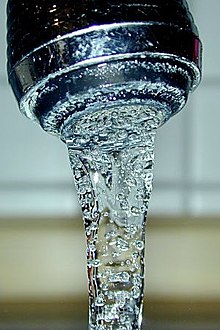Penyediaan air: Perbedaan antara revisi
k Bot: Perubahan kosmetika |
k →Lihat pula: + |
||
| (3 revisi perantara oleh 2 pengguna tidak ditampilkan) | |||
| Baris 26: | Baris 26: | ||
* [[Penyakit yang ditularkan melalui air]] |
* [[Penyakit yang ditularkan melalui air]] |
||
* [[Terorisme penyediaan air]] |
* [[Terorisme penyediaan air]] |
||
* [[Sistem penyediaan air minum Sepaku IKN]] |
|||
{{Div col end}} |
{{Div col end}} |
||
| Baris 40: | Baris 41: | ||
* [http://www.who.int/topics/water/en/ The WHO's site on water] |
* [http://www.who.int/topics/water/en/ The WHO's site on water] |
||
* [http://www.oecd.org/water The OECD's site on water] |
* [http://www.oecd.org/water The OECD's site on water] |
||
* [http://www.spectrum.ieee.org/apr08/6182 IEEE Spectrum: How Much Water Does It Take to Make Electricity?] — Natural gas requires the least water to produce energy, biofuels the most, according to a new study |
* [http://www.spectrum.ieee.org/apr08/6182 IEEE Spectrum: How Much Water Does It Take to Make Electricity?] {{Webarchive|url=https://web.archive.org/web/20090210045405/http://www.spectrum.ieee.org/apr08/6182 |date=2009-02-10 }} — Natural gas requires the least water to produce energy, biofuels the most, according to a new study |
||
* [http://www.waterplanning.org.au Water Planning Tools] — an Australian research initiative which develops and pilots tools for improving water planning, management and security |
* [http://www.waterplanning.org.au Water Planning Tools] {{Webarchive|url=https://web.archive.org/web/20090212055152/http://waterplanning.org.au/ |date=2009-02-12 }} — an Australian research initiative which develops and pilots tools for improving water planning, management and security |
||
* [http://www.google.com/publicdata/explore?ds=d5bncppjof8f9_&ctype=l&strail=false&nselm=h&met_y=sh_h2o_safe_zs&hl=en&dl=en Google — public data] "Improved water source (percent of population with access)" |
* [http://www.google.com/publicdata/explore?ds=d5bncppjof8f9_&ctype=l&strail=false&nselm=h&met_y=sh_h2o_safe_zs&hl=en&dl=en Google — public data] "Improved water source (percent of population with access)" |
||
* [http://www.google.com/publicdata/explore?ds=d5bncppjof8f9_&ctype=l&strail=false&nselm=h&met_y=er_h2o_intr_pc&hl=en&dl=en Google — public data] "Renewable internal freshwater resources per capita (cubic meters)" |
* [http://www.google.com/publicdata/explore?ds=d5bncppjof8f9_&ctype=l&strail=false&nselm=h&met_y=er_h2o_intr_pc&hl=en&dl=en Google — public data] "Renewable internal freshwater resources per capita (cubic meters)" |
||
| Baris 47: | Baris 48: | ||
{{Authority control}} |
{{Authority control}} |
||
[[Kategori: |
[[Kategori:Suplai air]] |
||
[[Kategori: |
[[Kategori:Manajemen air]] |
||
Revisi terkini sejak 30 Agustus 2024 00.08


Penyediaan air adalah penyediaan air oleh fasilitas umum, organisasi komersial, upaya masyarakat atau perorangan, yang mana biasanya dilakukan melalui suatu sistem pompa dan pipa. Irigasi dibahas secara terpisah dari topik ini.
Akses global ke air bersih
[sunting | sunting sumber]
Pada tahun 2010, sekitar 85% populasi global (6,74 miliar orang) telah memiliki akses ke penyediaan air melalui pipa baik dengan cara sambungan ke rumah ataupun suatu sumber air yang diperbaiki melalui cara lain selain sambungan rumah seperti pipa leding berdiri, kios air, penyediaan langsung dari mata air, dan sumur yang terlindungi. Namun sekitar 14% (884 juta orang) tidak memiliki akses ke sumber air yang diperbaiki dan harus menggunakan mata air atau sumur yang tak terlindungi, kanal, danau atau sungai untuk memenuhi kebutuhan mereka akan air.[1]
Suatu pasokan air bersih—khususnya air yang tidak tercemar dengan materi feses karena kurangnya sanitasi—adalah faktor penentu yang paling penting dalam kesehatan masyarakat.[butuh rujukan] Kerusakan pasokan air dan/atau infrastruktur sanitasi setelah bencana besar (gempa bumi, banjir, perang, dll.) menyebabkan ancaman langsung epidemi yang parah dari penyakit yang ditularkan melalui air, yang mana beberapa di antaranya dapat mengancam jiwa.
Lihat pula
[sunting | sunting sumber]- Air minum
- Daftar sanitasi dan penyediaan air berdasarkan negara
- Efisiensi air
- Hak atas air
- Hukum sumber daya air
- Jaringan penyediaan air
- Keamanan infrastruktur
- Kebijakan sumber daya air
- Kelangkaan air
- Konflik air
- Kredit mikro untuk sanitasi dan penyediaan air
- Penyakit yang ditularkan melalui air
- Terorisme penyediaan air
- Sistem penyediaan air minum Sepaku IKN
Referensi
[sunting | sunting sumber]- ^ Progress on Sanitation and Drinking-water: 2010 Update, UNICEF, WHO/UNICEF Joint Monitoring Programme for Water Supply and Sanitation, ISBN 978-92-4-156395-6
Pranala luar
[sunting | sunting sumber]- Water Resources di Curlie (dari DMOZ)
- The World Bank on private water operations in rural communities
- The World Bank on public-private water mechanisms for urban utilities
- The World Bank on water utility subsidies
- Appropedia:Water supply
- The WHO's site on water
- The OECD's site on water
- IEEE Spectrum: How Much Water Does It Take to Make Electricity? Diarsipkan 2009-02-10 di Wayback Machine. — Natural gas requires the least water to produce energy, biofuels the most, according to a new study
- Water Planning Tools Diarsipkan 2009-02-12 di Wayback Machine. — an Australian research initiative which develops and pilots tools for improving water planning, management and security
- Google — public data "Improved water source (percent of population with access)"
- Google — public data "Renewable internal freshwater resources per capita (cubic meters)"
